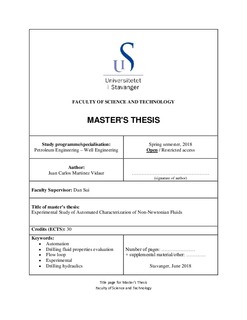| dc.contributor.advisor | Sui, Dan | |
| dc.contributor.author | Martinez Vidaur, Juan Carlos | |
| dc.date.accessioned | 2018-10-29T10:00:16Z | |
| dc.date.available | 2018-10-29T10:00:16Z | |
| dc.date.issued | 2018-06-08 | |
| dc.identifier.uri | http://hdl.handle.net/11250/2569905 | |
| dc.description | Master's thesis in Petroleum engineering | nb_NO |
| dc.description.abstract | The automation of the drilling fluid properties measurement is a research area that has been pursued in the last few years by the oil industry. Adequate control and monitoring of the density and rheology of the drilling mud have been fundamental responsibilities of the Mud Engineer and the Derrickman; this reliance in human intervention introduces a range of error and uncertainty in the measurements. A system that could provide automated measurements in real-time of the most critical fluid properties, namely density and viscosity, would significantly improve the control over the fluid that goes into the well, thus reducing drilling problems associated to improper management of the bottom hole pressure.
A setup that emulates a measurement system that could be installed in the standpipe of a drilling rig was built at the University of Stavanger in 2016. The basic concept is to measure the differential pressure in two sections of pipe: one horizontal and one vertical; based on this pressure data, a mathematical model is then used to estimate the density of the fluid and subsequently the viscosity. Last year, a first study to validate the measurements and the mathematical model used in the algorithm was conducted with Newtonian and Non-Newtonian Fluids. The results obtained showed significant discrepancies, particularly in the density measurements arguably related to the foam appearance in the flowloop setup.
This thesis explores further the applicability of the automated measurement of drilling fluid properties using the instrumented standpipe concept; a wider set of fluid formulations has been studied extending the analysis to heavier densities. The study has been constrained to solids-free fluid formulations due to the limitations of the current flowloop setup. It is recommended to continue this research in the future by modifying the system at UiS to accommodate the safe handling and disposal of weighted muds and potentially even oil-based drilling fluids using a non-smooth pipe. | nb_NO |
| dc.language.iso | eng | nb_NO |
| dc.publisher | University of Stavanger, Norway | nb_NO |
| dc.relation.ispartofseries | Masteroppgave/UIS-TN-IEP/2018; | |
| dc.subject | petroleumsteknologi | nb_NO |
| dc.subject | petroleum engineering | nb_NO |
| dc.subject | automation | nb_NO |
| dc.subject | drilling fluid properties evaluation | nb_NO |
| dc.subject | boreteknologi | nb_NO |
| dc.title | Experimental Study of Automated Characterization of Non-Newtonian Fluids | nb_NO |
| dc.type | Master thesis | nb_NO |
| dc.subject.nsi | VDP::Teknologi: 500::Berg‑ og petroleumsfag: 510::Petroleumsteknologi: 512 | nb_NO |
